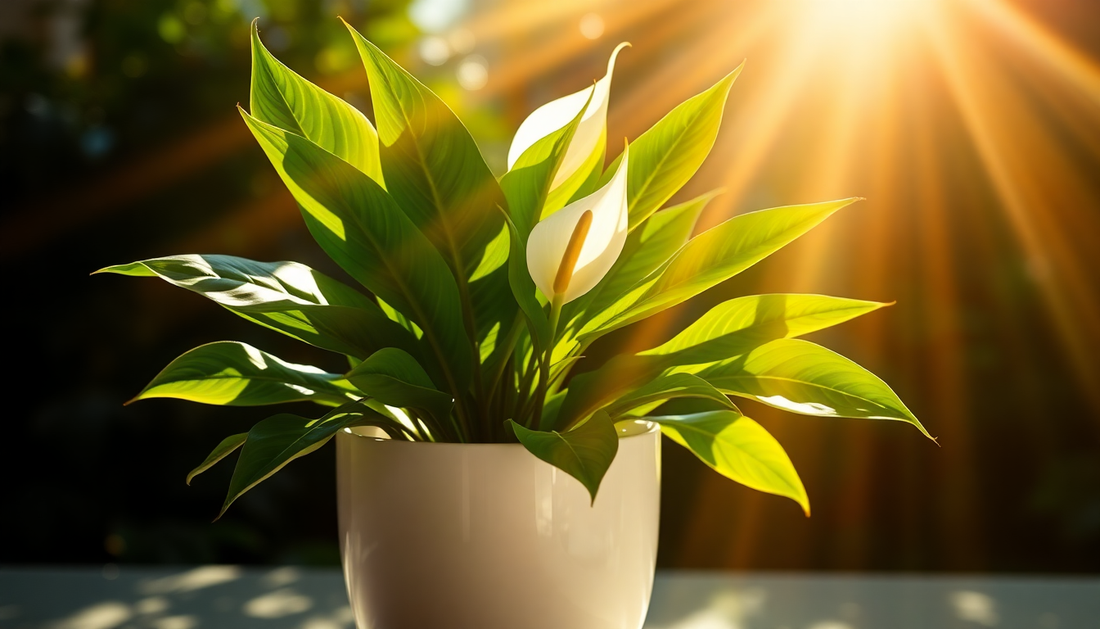
Caring for Your Peace Lily in Direct Sunlight
As the sun's rays stream through your windows, you may be tempted to place your beloved peace lily in a prime spot to soak up the natural light. However, before you do so, it's crucial to understand the unique needs of this delicate plant and how to ensure it thrives in direct sunlight.
The peace lily, scientifically known as Spathiphyllum, is a popular indoor plant known for its lush, green foliage and striking white flowers. While these plants can tolerate a range of lighting conditions, they have specific requirements when it comes to direct sunlight exposure.
Understanding the Peace Lily's Light Needs
Peace lilies are native to the tropical rainforests of Central and South America, where they grow in the dappled shade of the forest canopy. In their natural habitat, they are accustomed to receiving filtered light, rather than the intense, direct sunlight that can be found in many homes and offices.
In their natural environment, peace lilies thrive in an environment with bright, indirect light. This means they receive ample illumination, but the light is softened by the surrounding vegetation. When exposed to direct sunlight, these plants can quickly become stressed and exhibit signs of distress.
The Risks of Direct Sunlight
Placing a peace lily in direct sunlight can have several adverse effects on the plant's health and appearance. Here are some of the potential issues you may encounter:
Leaf Discoloration
The delicate leaves of the peace lily can become discolored and develop unsightly brown or yellow patches when exposed to intense, direct sunlight. This is the plant's way of trying to protect itself from the damaging UV rays.
Wilting and Drooping
One of the most noticeable signs of a peace lily in distress is the wilting and drooping of its leaves. The plant may appear to be thirsty, even if it has been recently watered. This is a defense mechanism to reduce the amount of surface area exposed to the sun's rays.
Stunted Growth
Prolonged exposure to direct sunlight can also inhibit the peace lily's growth, causing it to become stunted and fail to thrive. The plant may allocate its resources to survival rather than new leaf and flower production.
Increased Susceptibility to Pests and Diseases
When a peace lily is stressed by direct sunlight, it becomes more vulnerable to pests and diseases. The plant's natural defenses may be compromised, making it an easier target for common houseplant issues.
Optimal Lighting Conditions for Peace Lilies
To ensure your peace lily remains healthy and vibrant, it's essential to provide it with the right lighting conditions. Here are some tips for creating the perfect environment:
Bright, Indirect Light
Aim to place your peace lily in a spot that receives bright, indirect light. This could be near a north- or east-facing window, where the sun's rays are filtered through curtains or blinds. Avoid direct exposure to the sun, especially during the hottest parts of the day.
Gradual Acclimation
If you're moving your peace lily to a new location with more light, do so gradually. Expose the plant to slightly more light each day to allow it to adapt to the new conditions. This will help prevent sudden stress and damage.
Rotate the Plant
To ensure even light exposure, consider rotating your peace lily periodically. This will help prevent one side of the plant from receiving more direct sunlight than the other, which can lead to uneven growth and discoloration.
Supplement with Artificial Light
If your home doesn't receive enough natural light, you can supplement with artificial lighting. Place the peace lily under a grow light or fluorescent bulb, ensuring it receives at least 6-8 hours of illumination per day.
Caring for Your Peace Lily in Direct Sunlight
If you've already placed your peace lily in a spot with direct sunlight, don't panic. There are steps you can take to help the plant recover and thrive:
Move to a Shaded Area
As soon as possible, relocate your peace lily to a spot with bright, indirect light. This will give the plant a chance to recover and prevent further damage.
Adjust Watering Habits
Peace lilies in direct sunlight may require more frequent watering, as the intense light can cause the soil to dry out more quickly. Keep a close eye on the plant and water when the top inch of soil becomes dry.
Prune Damaged Leaves
If your peace lily has developed discolored or wilted leaves, gently prune them off. This will encourage the plant to focus its energy on new, healthy growth.
Monitor for Pests and Diseases
Keep a close eye on your peace lily for any signs of pests or diseases, as the plant may be more susceptible to these issues when stressed.
Conclusion
Caring for a peace lily in direct sunlight requires a delicate balance of light exposure, watering, and vigilance. By understanding the plant's needs and making adjustments as necessary, you can help your peace lily thrive and continue to be a beautiful addition to your indoor garden.
Remember, patience and attention to detail are key when it comes to caring for this sensitive plant. With the right care, your peace lily will reward you with its lush foliage and stunning white flowers for years to come.







No comments